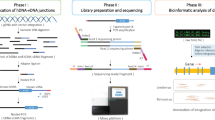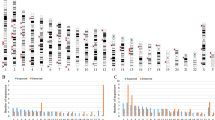Abstract
Ligation-mediated-PCR was performed followed by the mapping of 177 and 150 integration sites from HepG2 and Hek293 transduced with chimera vector carrying recombinant human Factor IX (rhFIX) cDNA, respectively. The sequences were analyzed for chromosome preference, CpG, transcription start site (TSS), repetitive elements, fragile sites and target genes. In HepG2, rhFIX was had an increased preference for chromosomes 6 and 17; the median distance to the nearest CpG islands was 15,240 base pairs and 37 % of the integrations occurred in RefSeq genes. In Hek293, rhFIX had an increased preference for chromosome 5; the median distance to the nearest CpG islands was 209,100 base pairs and 74 % of the integrations occurred in RefSeq genes. The integrations in both cell lines were distant from the TSS. The integration patterns associated with this vector are different in each cell line.


Similar content being viewed by others
References
Adachi N, Lieber MR (2002) Bidirectional gene organization: a common architectural feature of the human genome. Cell 109:807–809
Aker M, Tubb J, Miller DG et al (2006) Integration bias of gammaretrovirus vectors following transduction and growth of primary mouse hematopoietic progenitor cells with and without selection. Mol Ther 14:226–235
Appelt JU, Giordano FA, Ecker M et al (2009) QuickMap: a public tool for large-scale gene therapy vector insertion site mapping and analysis. Gene Ther 16:885–893
Castilho-Fernandes A, de Almeida DC, Fontes AM et al (2011) Human hepatic stellate cell line (LX-2) exhibits characteristics of bone marrow-derived mesenchymal stem cells. Exp Mol Pathol 91:664–672
Conley AB, Piriyapongsa J, Jordan IK (2008) Retroviral promoters in the human genome. Bioinformatics 24:1563–1567
Cordaux R, Batzer MA (2009) The impact of retrotransposons on human genome evolution. Nat Rev Genet 10:691–703
Deaton AM, Bird A (2011) CpG islands and the regulation of transcription. Genes Dev 25:1010–1022
Kaleko M, Garcia JV, Miller AD (1991) Persistent gene expression after retroviral gene transfer into liver cells in vivo. Hum Gene Ther 2:27–32
Khan KH (2013) Gene expression in mammalian cells and its applications. Adv Pharm Bull 3:257–263
Lander ES, Linton LM, Birren B et al (2001) Initial sequencing and analysis of the human genome. Nature 409:860–892
Legrier ME, Yang CP, Yan HG et al (2007) Targeting protein translation in human non small cell lung cancer via combined MEK and mammalian target of rapamycin suppression. Cancer Res 67:11300–11308
Matsushita T, Emi N, Takahashi I et al (1993) Construction and its expression of a new retroviral vector containing a human blood coagulation factor IX cDNA. Thromb Res 69:387–393
Mikkers H, Berns A (2003) Retroviral insertional mutagenesis: tagging cancer pathways. Adv Cancer Res 88:53–99
Mitchell RS, Beitzel BF, Schroder AR et al (2004) Retroviral DNA integration: ASLV, HIV, and MLV show distinct target site preferences. PLoS Biol 2:E234
Moalic Y, Blanchard Y, Felix H et al (2006) Porcine endogenous retrovirus integration sites in the human genome: features in common with those of murine leukemia virus. J Virol 80:10980–10988
Narezkina A, Taganov KD, Litwin S et al (2004) Genome-wide analyses of avian sarcoma virus integration sites. J Virol 78:11656–11663
Russo-Carbolante EM, Picanco-Castro V, Alves DC et al (2011) Integration pattern of HIV-1 based lentiviral vector carrying recombinant coagulation factor VIII in Sk-Hep and 293T cells. Biotechnol Lett 33:23–31
Santoni FA, Hartley O, Luban J (2010) Deciphering the code for retroviral integration target site selection. PLoS Comput Biol 6:e1001008
Stenderup K, Justesen J, Clausen C et al (2003) Aging is associated with decreased maximal life span and accelerated senescence of bone marrow stromal cells. Bone 33:919–926
Wajih N, Hutson SM, Owen J et al (2005) Increased production of functional recombinant human clotting factor IX by baby hamster kidney cells engineered to overexpress VKORC1, the vitamin K 2,3-epoxide-reducing enzyme of the vitamin K cycle. J Biol Chem 280:31603–31607
Wong N, Lai P, Pang E et al (2000) A comprehensive karyotypic study on human hepatocellular carcinoma by spectral karyotyping. Hepatology 32:1060–1068
Wu X, Li Y, Crise B et al (2003) Transcription start regions in the human genome are favored targets for MLV integration. Science 300:1749–1751
Wurtele H, Little KC, Chartrand P (2003) Illegitimate DNA integration in mammalian cells. Gene Ther 10:1791–1799
Acknowledgments
Authors would like to thank: FINEP (Grant no 01.07.0652.00), FAPESP (Grant no 1998/14247-6), CNPq (Grant no 310619/2012-2 and 2008/57877-3). KJA also acknowledges financial support of the program Professor Visitante do Exterior of CAPES (Grant no 6327109) and Pesquisador Visitante Internacional of USP (Grant no 13.1.1318.17.3). Also, Sandra Navarro Bresciani for helping with the figures.
Author information
Authors and Affiliations
Corresponding author
Additional information
Kuruvilla Joseph Abraham: Bolsista Professor Visitante/FMRP-USP.
Rights and permissions
About this article
Cite this article
Castilho-Fernandes, A., Fontes, A.M., Abraham, K.J. et al. Significant differences in integration sites of Moloney murine leukemia virus/Moloney murine sarcoma virus retroviral vector carrying recombinant coagulation factor IX in two human cell lines. Biotechnol Lett 37, 991–1001 (2015). https://doi.org/10.1007/s10529-014-1764-2
Received:
Accepted:
Published:
Issue Date:
DOI: https://doi.org/10.1007/s10529-014-1764-2




